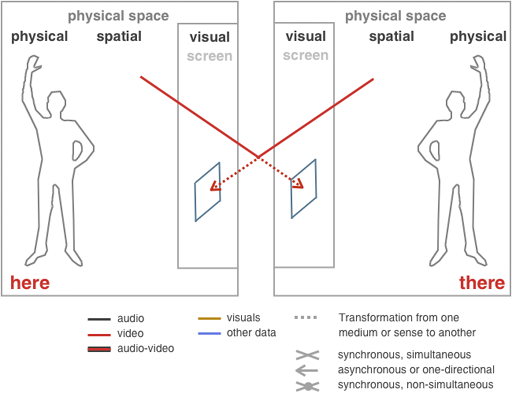Paul Sermon, "Telematic Vision," 1993 
|
|||
|
The immediate physical space stays behind while the participants are drawn into the telematic space of the mixed scenery appearing on their tv screens. 1 The unusual situation of sharing close - though virtual - physical closeness to total strangers while not being constrained by conventional spatial restrictions leads to a significant change in social interaction. Participants can invade the virtual social space of such a stranger and break the conventional, social and spatial rules in this new situation. They can for example “touch” or interact with the representation of the remote person, and it depends on the spontaneity of the other individual how she reacts to this invasion of private space. This live pictorial representation creates a new social space, a telematic space which the participants inhabit and interact in. The arrangement leads to playful, vivid, non-verbal interaction among the sofas occupants and their remote parties. Sound is not necessary in this work as the body and gestures suffice for interaction. Although the interaction takes place in telematic-space it is a work about physical space, social space and the human body. |
|||

Here, there: Transformation and Spatiality: Telematic Vision: Two live video sources are digitally transformed. Both parties receive identical video streams. The spatial separation is more important than the geographical location as such. The interaction is spatial, no physical objects have to be handled. The crossing of the two lines suggests that the connection facilitates a synchronous and simultaneos dialogue and not two one-way connections. The dotted lines indicate that a transformation is applied, in this case a digital conflation of the two different sceneries to a single one. The two remote locations are merged into one virtual one allowing for novel interactions and communication playing with our perceptions of space and social conventions. |
|||
Notes:1. In the respect that participants are drawn into the virtual space of the screen the piece loosely resembles Myron Kruger’s “responsive environment” “Videoplace” from 1969. Here participants playfully interact via gestures with augmented visuals using their own physical shadow (Wilson, 2003, 735). Links: |
|||
| last update: 1/7/02008 0:53 About Contact Disclaimer Glossary Index |
|||
